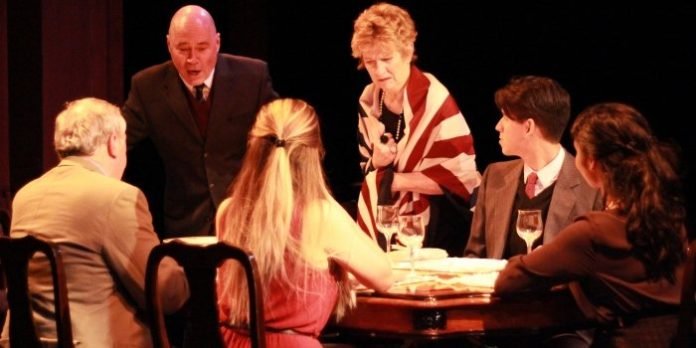There is a scene at the top of act two that pretty much sums up A.R. Gurney’s The Dining Room. As a young university student photographs his aunt going through the ritual of setting her table with the family’s heirloom silverware and fine china, we discover that his interest isn’t in learning the art of the finger bowl, but comes from an anthropology assignment to study the eating rituals of dying cultures.
In The Dining Room, that culture is the White Anglo-Saxon Protestant (WASP), a group of moneyed and influential white Americans that we would refer to as the one-percenters today, Using the dining room as both backdrop and metaphor, for nearly two hours Gurney explores what only can be described as rich white people problems.
While it is tough to get too excited about the problems of privileged white folk, Gurney’s structure of overlapping vignettes is nonetheless interesting. In its non-linear timeline, the scenes jump across the past century and various families. As the ensemble waits on the sidelines for their next entrance, Gurney catalogues a multitude of WASP stereotypes that include everything from marital infidelities, money, family secrets, and that near obsessive adherence to proper etiquette.
It is in those moments where Gurney goes on the offense that things get at all interesting; unfortunately those moments are few-and-far-between. One of the best scenes of the night comes as one of characters, played with perfection by Adele Noronha, looks to repurpose the family’s unused dining room into her study. Met with a uncharacteristically strong resistance from her husband, she eventually gives up, declaring it to be a room that suppresses her creativity.

That isn’t to say that Gurney misses the mark completely even as the situations get into the more mundane, but those scenes largely work because of the choices made by some of this cast of six that includes Dion-Richard, Alex Dominguez, Keith Martin Godrey, Anna Hagan, Adele Noronha, and John Prowse.
In one particularly interesting scene, Dominguez and Gordey create a wonderful tension as they face off as grandson and grandfather in a discussion of the younger’s future and access to his grandfather’s cheque book. And in one of the more relatable scenes, Gurney gives a tug at the heart strings as a family struggles with Alzheimer’s as they sit around the dining room table for Thanksgiving dinner. Where this could easily have devolved into a mawkish mess, the performances are restrained and real.
For the most part though, Gurney’s characters and the circumstances they find themselves in are ultimately forgettable, lacking any real bite. The only real irony comes from a couple of director Chelsea Haberlin’s casting choices, and in a clever opening sequence that places Glenn MacDonald’s handsome set behind the velvet ropes of a museum, lit by John Webber’s beautiful sepia tones.
In the end, The Dining Room largely feels as creaky as the chairs that are placed around it. I would have much preferred to have been in the kitchen, where we know all of the good stuff really happens.
The Dining Room by A.R. Gurney. Directed by Chelsea Hablerin. A Western Gold Theatre production. On stage at the PAL Studio Theatre (581 Cardero St, Vancouver) until November 8. Visit https://westerngoldtheatre.org for tickets and information.

